The Scottish-Irish Orange Connection
Published in 18th–19th - Century History, Features, Issue 3 (Autumn 1999), Volume 7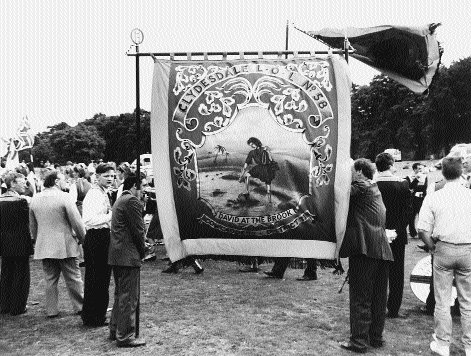
(Neil Jarman)
No better reminder of one of Ireland’s most distinctive contributions to Scottish society could have been found than the parade held by the Loyal Orange Institution of Scotland in the south Ayrshire town of Cumnock on 12 September 1998. Its purpose was to commemorate the bicentenary of the arrival of Orangeism in Scotland, only three years after its foundation in Loughgall, County Armagh, in 1795. For much of that period, but especially since the 1870s, there has been a close interaction between the two Orange jurisdictions, with a large two way movement each July as Orangemen and bands from Northern Ireland cross the North Channel to parades in Scotland before their Scottish counterparts return the compliment. To anyone acquainted with working class areas in the central belt of Scotland, the sights and sounds of Orange parades, or ‘walks’ as they are usually called, are perfectly familiar, while to other sections of Scottish society these demonstrations have seemed either an embarrassing throwback to earlier sectarian divisions or, even worse, a strident and unwelcome echo of the Northern Ireland ‘Troubles’. A prime example of the former is the 1958 Third Statistical Account of the City of Glasgow, which consigned to a dismissive footnote the annual Orange walk in which thousands of Glaswegians took part, as they still do. As a measure of certain attitudes it was quite telling, but was not much of an aid to understanding. Few Scottish organisations can claim a two hundred year-old pedigree and fewer still could put thousands of members on to the streets every July. Why this is so and why so many Scots feel it necessary to commemorate a three hundred year-old Irish battle does merit reflection. Fortunately, in the past decade the studies by Elaine McFarland and William S. Marshall have given Orangeism something of its place in our understanding of Scottish history and of the Irish-Scottish connection.
Origins
Sources for the early history of Orangeism in Scotland are meagre but it is probable that the idea was brought to Ayrshire by members of the Loyal Carrick Volunteers, one of several Scottish militia units which had served in Ireland during the 1798 Rebellion. Once lodges were established, their ranks attracted Protestant immigrants from Ulster, so that by 1821 there was the first attempt at an Orange parade in Glasgow. In the 1830s, the order survived the parliamentary inquiry set up as the result of the ‘Orange plot’ to put the Duke of Cumberland on the throne. In the mid-century the lodge structure remained in place and was able to accommodate the large numbers of Ulster Protestant immigrants coming to work in the factories, shipyards and coal mines of industrial Scotland. The order’s advance in the 1870s seems to reflect a reaction to the continuing Irish Catholic immigration and to the growth of nationalism in Ireland itself. In 1872, some 5,000 attended the opening of the first Orange hall in Scotland, at Irvine on the Ayrshire coast. McFarland has charted the steady growth of Orange parades from 1872. By the late nineteenth century, Orangeism was an established fact of Scottish working class life and had formed an alliance, albeit not always a straightforward one, with the Conservatives. There were presumed advantages for each side. To the Orangemen, members like Lord Blythswood, President of the Glasgow Conservative Association, conferred a respectability in Scottish society which had hitherto eluded them. To the Conservatives, the extension of the male franchise gave them the incentive to reach out to working class Protestants, as they also did in Liverpool and other parts of Lancashire. What gave the two organisations a common purpose was the prospect of Home Rule for Ireland, which they saw as threatening both Protestant and imperial interests. The alliance was never totally stable and formally ended in 1922 when Scottish Orangemen opposed the Irish settlement. Even so, strong Irish Catholic influence in the Labour party and the work of Orange Conservatives like the Grand Master, Sir Archibald MacInnes Shaw, and the long-serving MP for Ayr Burghs, Sir Thomas Moore, meant that even forty years later there was an identifiable ‘Orange Tory’ vote in parts of Scotland.
Decline and retrenchment
What would have happened to Scottish Orangeism had the Ulster situation not turned violent in 1969 is difficult to say. It might well have gone the way of its sister organisation in Canada. The work of Cecil Houston and William Smyth has shown how Canadian Orangeism, which once dominated the politics of Ontario, sharply declined from the 1960s for reasons which are instructive for our understanding of the movement in Scotland. Here they identify the sharp decline in imperial sentiment and the growth of a Canadian identity, the secularisation of society and the growth of ecumenism, and a fracturing of traditional communities through suburbanisation.
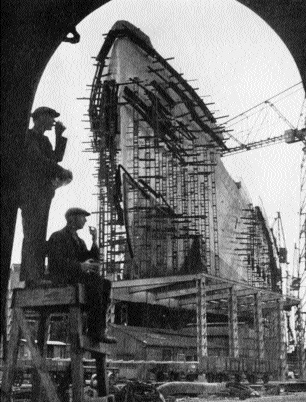
The parallels with Scotland are clear. The imperial sentiment which had once made Glasgow a bastion of empire vanished in the 1960s as Britain moved towards joining the European Economic Community. Its place was increasingly taken by a Scottish identity, which cannot be divorced from the place in politics of the Scottish National Party after 1967, and which was to lead to the re-establishment of a Scottish parliament in 1999. Church attendances declined and in the aftermath of the Second Vatican Council the Church of Scotland and the Roman Catholic Church moved towards a warmer relationship. Attitudes in the Kirk towards the Order, always ambivalent, became increasingly tepid. Old-established areas of Glasgow, with substantial ‘Orange’ populations, were torn down, their populations sent either to the vast peripheral housing estates like Drumchapel and Easterhouse, or to the new towns of East Killbride, Cumbernauld and Irvine. Perhaps symbolic of this process was the demolition of the main Orange Halls in Cathedral Street to make way for redevelopment. At the same time, the industries where Orangemen had been well represented, the Clyde shipyards and the Lanarkshire and north Ayrshire steelworks, went into steep, even terminal, decline. The mining towns and villages from south Ayrshire to the Lothians, where the Orange lodges were strongly based, also saw their pits close and their economic raison d’être disappear. In a post-imperial, post industrial, secularised Scotland, the prospects for an institution whose banners proclaimed loyalty to the Protestant religion and the British crown did not look inviting. Moreover, while religious divisions remained, most Scots had little problem in seeing the large population of Irish Catholic descent as long since assimilated into national life and certainly no wish to see Northern Ireland’s disputes cross the North Channel.
In the face of these pressures, it is not surprising that a degree of attrition took place. The Vale of Leven in Dunbartonshire, once a strong centre of Orangeism, was reduced to a single lodge. In Clydebank the Order was hit by the closure of John Brown’s Shipyard and the Singer sewing machine factory. Other areas saw lodges having to close. But many Orangemen retained allegiance to their old inner city Orange districts. Despite the problems in the shipbuilding industry, in 1998 Govan District retained twenty-two adult, one junior and two juvenile lodges, while the east end Dennistoun District had ten male, eight female, one juvenile and one junior lodge. Other Orangemen preferred to set up in their new localities, with some success. A new Drumchapel District Lodge was started, opening its Orange Hall in 1972 and growing to seven adult and three junior and juvenile lodges. There was also some geographical expansion, with lodges opening in Aberdeen, Peterhead and Forfar in the north-east, and a new District Lodge of Argyll and the Isles in 1998, with lodges in Campbeltown, Dunoon and Strachur. A further growth took place in the Apprentice Boys of Derry, a related, but completely separate, organisation. In the late 1950s, a few enthusiasts decided to expand the Association in Scotland, establishing branches of the Walker Club in Caldercruix and Irvine. By the late 1990s, the Scottish Amalgamated Committee of the Apprentice Boys presided over a network of some forty clubs, stretching from Aberdeen in the north to Maybole in the south, with the Ayrshire coast a particular area of support. Since all Apprentice Boys must travel to be initiated within the walls of Derry, the Northern Ireland connection was particularly close. In short, the Orange Institution in Scotland, and its associated bodies, had reason to feel that it had met the challenges it had faced. Although other factors were at play, notably the order’s social role in many areas, there is little reason to doubt that the situation in Northern Ireland contributed to this.
The Orange Order in Northern Ireland
In some ways the Orange Institution in Scotland fared rather better than its Irish counterpart, though it is fair to say that the challenges were less dramatic. During the period of the Northern Ireland parliament and government, the prestige and influence of Orangeism were at their peak. As is well known, membership of the Institution was practically a requirement for an aspiring Unionist politician. Lord Craigavon and Lord Brookeborough managed to combine the highest offices of state with senior rank in the Institution.
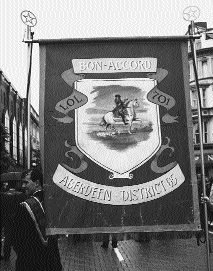
Aberdeen-an area of Orange expansion since the 1970s (Neil Jarman)
Terence O’Neill cut a rather less convincing figure on the Twelfth of July, but Brian Faulkner’s rise within the Unionist Party was closely tied to his role in the order. In the mid-1950s, Faulkner was identified with the controversial Orange parades on the Longstone Road in County Down, something which nationalists had not forgotten when he became Prime Minister. Orangeism in Scotland was never remotely as close to the centre of political power as it was in Northern Ireland between 1921 and 1972. Down to the 1960s, the Twelfth of July parades in Belfast were impressive symbols of unionist strength and self-confidence. Well-filled lodges paraded through the city to be addressed by Unionist cabinet ministers or sympathetic visiting Conservative MPs.
By the mid-1970s, this had begun to change. Perhaps the key date was 1972, since with the suspension of the Stormont parliament the old power structures began rapidly to disintegrate. Equally significant was the fracturing of unionism. Ian Paisley’s Democratic Unionist Party (DUP) proved a durable rival to ‘Official’ Unionism, while in working class areas many young Protestants found the Ulster Defence Association (UDA) and Ulster Volunteer Force (UVF) more convincing alternatives to the Orange Order as defenders of the loyalist position. Belfast, too, underwent massive demographic changes both as the result of civil disorder and inner city redevelopment. The consequences for Orangeism were significant. In areas like Portadown the Institution remained strong, as it did in parts of Belfast. No. 5 District in Sandy Row and No. 6 District in East Belfast retained large numbers of lodges, but elsewhere in the city adjustments had to be made. In 1994, Districts 7 and 8 in North Belfast merged. The numbers parading in many city lodges were much reduced from what they had been before 1972.
The character of Orangeism also underwent subtle changes. Although both in Northern Ireland and Scotland the Orange Institution amounts to much more than its annual demonstrations, nevertheless parading is its public face. During the period of the Northern Ireland government, Orange processions were in a sense part of the fabric of the state and certainly supportive of it. But since 1972, as the unionist community became uncertain of its position, parades have become more oppositional in tone. This can be seen in the changing character of the bands. Pipe bands and brass bands have long disappeared from the Belfast parade, though the former are still well represented in certain country areas. Some well established flute and accordion bands have held their position and maintain a high musical standard, but the tone of parades has increasingly been set by the so-called ‘blood and thunder’ flute bands. Largely recruited from working class Protestant communities, these bands have no formal connection with the Orange Institution but are hired by lodges for the occasion. It is also worth noting the large number of Scottish bands leading lodges in the Belfast Twelfth parade; in 1996, of the seventy-seven bands in the Belfast parade, twenty-six were from Scotland.
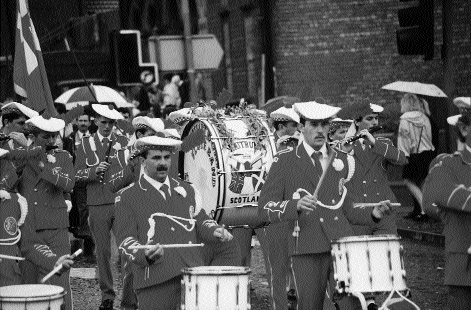
In 1996 of the seventy-seven bands on the Belfast Twelfth parade, twenty-six were from Scotland. (Neil Jarman)
For a number of years Glasgow’s Black Skull Flute Band has led the General Committee at the head of the Apprentice Boys parade. The relationships built up as a result of this form part of the Scottish-Ulster Orange connection.
The Orange Institution has also had to adapt in other directions. Just as the leaders of Scottish Orangeism realised that many of their members were supporting the Labour Party, it was clear that many Ulster Orangemen were voting for the DUP and, more recently, for the Progressive Unionist Party and the Ulster Democratic Party. Unlike the Apprentice Boys of Derry, which severed the connection, the Orange Institution is still represented on the Ulster Unionist Council. This relationship was increasingly questioned on both sides and the tensions were revealed in the aftermath of the Good Friday Agreement when the Unionist Party supported David Trimble’s position, while the Orange lodges, in the main, did not. Further tensions were generated over the issue of parading. After the first Drumcree stand-off in 1995, the future of its parades in certain areas became an over-riding issue for the Institution. Radical critics within the order found their voice in the Spirit of Drumcree Group which opposed compromise over established parading routes and argued for more democratic structures within the order. There is no doubt that it is parading, particularly the annual church parade of Portadown District to and from the Church of the Ascension at Drumcree, which has brought the position of the Orange Institution within Northern Ireland into sharp focus. As the debate has unfolded, Orangemen have increasingly argued that it is their culture that is at stake and which is under attack.
Orangeism and contemporary Scotland
Where does the Scottish movement stand in relation both to what has been happening in Northern Ireland and to the issues facing a changing Scotland? At first sight its values and ethos seem out of kilter with the times. Although many Kirk elders belong to the order, this is not reflected in the Church of Scotland clergy. City Orangemen were behind the establishment of the Glasgow Evangelical Church in 1979 and remain its mainstay, but attendance is difficult for members elsewhere. The impending bicentennial brought renewed tension between the order and the Kirk to the surface. A request for a service of thanksgiving in the Assembly Halls in Edinburgh was turned down and a subsequent petition to the General Assembly of the Church of Scotland to have the decision reversed failed. The order’s pained response was predictable, with the Grand Master, a church elder, announcing that while he was outraged by the decision he would not be resigning from the Kirk. The blow to the order was subsequently softened by an invitation from the minister of Glasgow Cathedral to hold a service there, but the whole affair was symptomatic of the poor relations between the Institution and the national church.
Perhaps even more problematic was the relationship between the order and the changing political and social life of Scotland, particularly as the country moved towards devolution. The whole ethos of the Institution was unashamedly unionist, its lodges led on parade by the Union Flag as well as the Scottish Saltire. Loyalty to the Crown was second only to the Protestant faith. On the political front, any connection with the Conservatives had been withering over a long period. The economic policies of the Conservative governments after 1979 were seen as devastating in their effects on traditional Scottish heavy industry and the coalfields where Orangeism was strongly rooted. The Anglo-Irish Agreement of 1985 was as strongly resented by Scottish Orangemen as it was amongst their Ulster counterparts. In her memoirs Margaret Thatcher noted the decline of the Scottish Orange Tory vote without wondering why this had come about. A short-lived response to the Anglo-Irish agreement was the announcement of the formation of a Scottish Unionist Party but in the end it did not contest any seats. It was, nonetheless, symptomatic of Orangeism’s isolation in Scottish politics.
Attitudes within the order to the prospect of devolution varied, since it was possible to advance a unionist argument on either side of the debate. Full independence as reflected in the position of the Scottish National Party was not an option. The March 1997 issue of the Orange Torch carried a lengthy article arguing that Scottish independence would not just be a disaster for Scotland but a betrayal of Ulster. In the summer of 1997, one member castigated the Conservatives for their philosophy of selfishness, but questioned the Labour government’s commitment to the Union. His answer was for the Order to get directly politically involved by reviving the Scottish Unionist Party. The Orange Torch’s response to the vote in favour of devolution was to issue a warning to unionists that they must not let nationalists wreck the Union. At least one senior Orangeman admitted that he had voted against devolution. As elections for the Scottish parliament approached, the argument for advancing a Scottish Unionist Party grew. The Institution reacted strongly to the suggestion that the Democratic Unionist Party might contest some Scottish seats, seeing it as affecting the overall unionist vote. Late in the day, the Scottish Unionist Party did put forward candidates. None was elected but the fact that the fledgling party won some 7,000 votes seemed to offer the prospect of winning over discontented Conservatives. Clearly, the great bulk of Orangemen and women had voted for other parties.
The Institution in Scotland continued to be closely engaged with events in Northern Ireland. The Orange Torch carried a regular column, ‘Ulster Forum’, written by the veteran Ulster Orangeman, Revd. S.E. Long. It also sought to take an even handed approach to the Good Friday Agreement, carrying pro-Agreement articles by David Trimble and Ken Maginnis and an anti-Agreement article by William Ross. As in Northern Ireland, parades caused problems for the order, though not remotely on the scale of Drumcree or other areas where difficulties had arisen in Northern Ireland. The Drumcree crisis in 1998 did embarrass the Institution in Scotland through the resignation of one of its Deputy Grand Masters. Contested parades in Scotland were usually in areas where the order was of recent growth. In the past few years, proposed parades in Aberdeen, Peterhead and Dumfries have aroused opposition. One Edinburgh newspaper also argued against the East of Scotland Orange demonstration in the city in June 1998. In the main, however, the problems over parades in Northern Ireland have affected Scottish Orangeism less than might have been expected. Orange parades remain an established feature of west-central Scotland, however out of tune they are with mainstream Scottish society.
Conclusion
This article has attempted to identify ways in which Orangeism has tried to adapt to changing circumstances on both sides of the North Channel. In Northern Ireland it is believed that its active support, at least in Belfast, is overwhelmingly working class, and in Scotland almost exclusively so. A major difference between the two is that while in Northern Ireland the order can draw upon a broad hinterland of support and sympathy in both political and religious circles, in Scotland this is not the case. Orangeism remains a potent factor in Northern Ireland life, notwithstanding the tensions within it generated by the Good Friday Agreement and the Drumcree controversies.
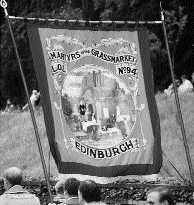
The order is certainly seen in the nationalist community as part of the unionist ascendancy which dominated their affairs during the Stormont period and it is that perception which has fuelled opposition to its parades in certain areas. The position in Scotland is less straightforward. The Institution retains substantial membership, not least in many of the communities worst hit by economic decline. Former mining villages, in particular, like Patna, Drongan, Annbank and Logan in south Ayrshire, seem to hold to their lodges as marks of continuing identity. A recently re-formed lodge at Netherthird near Cumnock has been named Miners Memorial, an appropriate title at several levels. Scottish Orangeism has long outgrown its Irish origins to become an established fact of life for thousands of working class Scottish Protestants. As such, it merits more than a footnote. Since Orangeism in Northern Ireland has increasingly assumed the mantle of cultural expression, perhaps its greatest challenge in Scotland is how it will adapt to a fast-evolving sense of ‘Scottishness’ both in politics and society at large.
T.G. Fraser is Professor of History at the University of Ulster.
Further reading:
T. Gallagher, Glasgow: The Uneasy Peace (Manchester 1987).
N. Jarman, Material Conflicts: Parades and Visual Displays in Northern Ireland (Berg 1997).
E. McFarland, Protestants First: Orangeism in nineteenth-century Scotland (Edinburgh 1990).
W.S. Marshall, ‘The Billy Boys’: A concise history of Orangeism in Scotland (Edinburgh 1996).
















